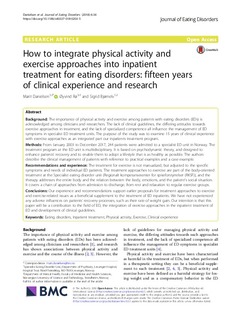| dc.contributor.author | Danielsen, Marit | |
| dc.contributor.author | Rø, Øyvind | |
| dc.contributor.author | Bjørnelv, Sigrid | |
| dc.date.accessioned | 2018-10-17T07:03:42Z | |
| dc.date.available | 2018-10-17T07:03:42Z | |
| dc.date.created | 2018-10-03T13:19:42Z | |
| dc.date.issued | 2018 | |
| dc.identifier.issn | 2050-2974 | |
| dc.identifier.uri | http://hdl.handle.net/11250/2568354 | |
| dc.description.abstract | Background: The importance of physical activity and exercise among patients with eating disorders (EDs) is acknowledged among clinicians and researchers. The lack of clinical guidelines, the differing attitudes towards exercise approaches in treatment, and the lack of specialized competence all influence the management of ED symptoms in specialist ED treatment units. The purpose of the study was to examine 15 years of clinical experience with exercise approaches as an integrated part our inpatients treatment program.
Methods: From January 2003 to December 2017, 244 patients were admitted to a specialist ED unit in Norway. The treatment program at the ED unit is multidisciplinary. It is based on psychodynamic theory, and designed to enhance patients’ recovery and to enable them to adopt a lifestyle that is as healthy as possible. The authors describe the clinical management of patients with reference to practical examples and a case example.
Recommendations and experience: The treatment for exercise is not manualized, but adjusted to the specific symptoms and needs of individual ED patients. The treatment approaches to exercise are part of the body-oriented treatment at the Specialist eating disorder unit (Regionalt kompetansesenter for spiseforstyrrelser (RKSF)), and the therapy addresses the entire body and the relation between the body, emotions, and the patient’s social situation. It covers a chain of approaches from admission to discharge, from rest and relaxation to regular exercise groups.
Conclusions: Our experience and recommendations support earlier proposals for treatment approaches to exercise and exercise-related issues as a beneficial supplement to the treatment of ED inpatients. We have not experienced any adverse influences on patients’ recovery processes, such as their rate of weight gain. Our intention is that this paper will be a contribution to the field of ED, the integration of exercise approaches in the inpatient treatment of ED and development of clinical guidelines. | nb_NO |
| dc.language.iso | eng | nb_NO |
| dc.publisher | BMC (part of Springer Nature) | nb_NO |
| dc.rights | Navngivelse 4.0 Internasjonal | * |
| dc.rights.uri | http://creativecommons.org/licenses/by/4.0/deed.no | * |
| dc.title | How to integrate physical activity and exercise approaches into inpatient treatment for eating disorders: fifteen years of clinical experience and research | nb_NO |
| dc.title.alternative | How to integrate physical activity and exercise approaches into inpatient treatment for eating disorders: fifteen years of clinical experience and research | nb_NO |
| dc.type | Journal article | nb_NO |
| dc.type | Peer reviewed | nb_NO |
| dc.description.version | publishedVersion | nb_NO |
| dc.source.journal | Journal of Eating Disorders | nb_NO |
| dc.identifier.doi | 10.1186/s40337-018-0203-5 | |
| dc.identifier.cristin | 1617599 | |
| dc.description.localcode | © The Author(s). 2018 Open Access This article is distributed under the terms of the Creative Commons Attribution 4.0 International License (http://creativecommons.org/licenses/by/4.0/) | nb_NO |
| cristin.unitcode | 194,65,35,0 | |
| cristin.unitname | Institutt for psykisk helse | |
| cristin.ispublished | true | |
| cristin.fulltext | original | |
| cristin.qualitycode | 1 | |

